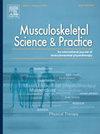非特异性慢性颈部疼痛对年轻女性平衡性、视觉运动反应时间和上肢爆发力的影响
IF 2.2
3区 医学
Q1 REHABILITATION
引用次数: 0
摘要
背景颈部有丰富的感觉受体,该区域的慢性疼痛会破坏传入信号,从而可能影响运动功能和平衡能力。目的研究非特异性慢性颈部疼痛对年轻女性平衡能力、视觉运动反应时间和上肢爆发力的影响。方法纳入 43 名参与者(颈部疼痛组:21 人;健康组:22 人)。静态平衡通过单腿站立测试(OLST)进行评估,动态平衡通过下四分之一Y型平衡测试(YBT)进行评估。视觉运动反应时间使用 FitLight Trainer™ 系统进行测量,该系统由 8 个 RGB 激光 LED 组成。结果颈部疼痛组的受试者在闭眼 OLST(p = 0.045)和优势下肢综合 YBT(p = 0.028)上的得分明显较低。颈部疼痛组的视觉运动反应时间明显延长(p = 0.032),而投掷药球测试的成绩明显下降(p = 0.030)。疼痛强度与视觉运动反应时间(r = 0.454; p = 0.002)和优势下肢的 YBT 综合得分(r = -0.356; p = 0.019)相关。此外,还观察到疼痛强度与视觉运动反应时间和动态平衡之间存在中度相关性,这表明疼痛强度越大,功能损伤越严重。本文章由计算机程序翻译,如有差异,请以英文原文为准。
Effects of nonspecific chronic neck pain on balance, visuomotor reaction time and upper extremity explosive strength in young females
Background
The cervical region is highly enriched with sensory receptors, and chronic pain in this area can disrupt afferent signals, potentially affecting motor function and balance.
Objective
To examine the effects of nonspecific chronic neck pain on balance, visuomotor reaction time, and upper extremity explosive strength in young females. The secondary objective was to investigate the relationship between neck pain intensity and the evaluated parameters.
Methods
Forty-three participants (Neck Pain Group: 21 participants; Healthy Group: 22 participants) were included. Static balance was assessed with the One-Leg Standing Test (OLST), and dynamic balance with the Lower Quarter Y Balance Test (YBT). Visuomotor reaction time was measured using the FitLight Trainer™ system, consisting of 8 RGB Laser LEDs. The Seated Medicine Ball Throw Test was employed to assess upper extremity explosive strength.
Results
Participants in the neck pain group exhibited significantly lower scores on the eyes-closed OLST (p = 0.045) and the composite YBT (p = 0.028) for the dominant lower extremity. Visuomotor reaction time was significantly prolonged in the neck pain group (p = 0.032), while performance in the medicine ball throw test was significantly reduced (p = 0.030). Pain intensity was correlated with visuomotor reaction time (r = 0.454; p = 0.002) and the composite YBT score of the dominant lower extremity (r = −0.356; p = 0.019).
Conclusion
This study's findings indicate that chronic neck pain negatively impacts balance, visuomotor reaction time, and upper extremity explosive strength. Furthermore, a moderate correlation was observed between pain intensity and both visuomotor reaction time and dynamic balance, suggesting that greater pain intensity is associated with greater functional impairment.
求助全文
通过发布文献求助,成功后即可免费获取论文全文。
去求助
来源期刊

Musculoskeletal Science and Practice
Health Professions-Physical Therapy, Sports Therapy and Rehabilitation
CiteScore
4.10
自引率
8.70%
发文量
152
审稿时长
48 days
期刊介绍:
Musculoskeletal Science & Practice, international journal of musculoskeletal physiotherapy, is a peer-reviewed international journal (previously Manual Therapy), publishing high quality original research, review and Masterclass articles that contribute to improving the clinical understanding of appropriate care processes for musculoskeletal disorders. The journal publishes articles that influence or add to the body of evidence on diagnostic and therapeutic processes, patient centered care, guidelines for musculoskeletal therapeutics and theoretical models that support developments in assessment, diagnosis, clinical reasoning and interventions.
 求助内容:
求助内容: 应助结果提醒方式:
应助结果提醒方式:


